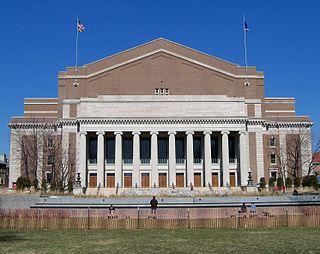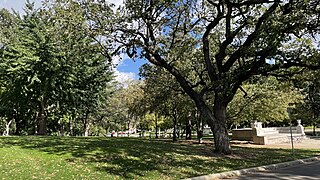Related Research Articles
The University of Minnesota system is a public university system with five campuses spread across the U.S. state of Minnesota.

The University of Minnesota is a public land-grant research university in the Twin Cities of Minneapolis and Saint Paul, Minnesota, United States. The Twin Cities campus comprises locations in Minneapolis and Falcon Heights, a suburb of St. Paul, approximately 3 mi (4.8 km) apart. The Twin Cities campus is the oldest and largest in the University of Minnesota system and has the ninth-largest main campus student body in the United States, with 52,376 students at the start of the 2021–22 academic year. It is the flagship institution of the University of Minnesota System, and is organized into 19 colleges, schools, and other major academic units.

The University of Minnesota Morris (UMN–Morris) is a public liberal arts college in Morris, Minnesota. It is part of the University of Minnesota system and was founded in 1960 as a public, co-educational, residential liberal arts college offering Bachelor of Arts degrees.

The University of Minnesota Rochester (UMR) is a public college in Rochester, Minnesota. It is part of the University of Minnesota system and focuses primarily on general health sciences. It was formally established by an act of the state legislature in December 2006. UMR currently offers two bachelor's degrees in the health sciences, Bachelor of Science in Health Sciences and Bachelor of Science in Health Professions.
Alliance University was a private Christian university affiliated with the Christian and Missionary Alliance. Located in New York, New York, the university offered undergraduate and graduate programs; in addition, it included Alliance Theological Seminary.

The University of Minnesota Crookston (UMN–Crookston) is a public college in Crookston, Minnesota. One of five campuses in the University of Minnesota system, UMN Crookston had a fall 2022 enrollment of 1,489 undergraduate students. Students come from 20 countries and 40 states.

Coffman Memorial Union is a student union on the East Bank campus of the University of Minnesota in Minneapolis. Situated near the Mississippi River, Coffman anchors the south end of Northrop Mall, a grassy area at the center of campus that is bordered by the University's physics, mathematics, chemistry, and administration buildings, plus Walter Library and Northrop Auditorium. Coffman sits at the south end of the mall, across Washington Avenue, and opposite Northrop.

Cyrus Northrop Memorial Auditorium is a performing arts venue at the University of Minnesota in Minneapolis, Minnesota. It is named in honor of Cyrus Northrop, the university's second president. Various events are held within the building, including concerts, ballet performances, lectures, and graduations.

The University of Minnesota Marching Band is the marching band of the University of Minnesota and the flagship university band for the state of Minnesota. The Pride of Minnesota serves as an ambassador for the university, representing the school at major events both on and off campus. The band performs before, during, and after all home Golden Gopher football games and bowl games, occasional away games, local parades, numerous pepfests, exhibition performances, as well as a series of indoor concerts toward the end of the regular football season. Members of the band, along with non-member students, also participate in smaller athletic pep bands that perform at other major sporting events, including men's hockey, men's basketball, women's hockey, women's basketball, and women's volleyball.

The University of Minnesota Old Campus Historic District is a historic district located in Minneapolis, Minnesota. Listed in the National Register of Historic Places since 1984, it includes a number of historic buildings that were constructed during the late 1800s and early 1900s, and represents the oldest extant section of the University of Minnesota campus. The general area was designed by landscape architect Horace W. S. Cleveland, who envisioned a park-like University. His plan, that he presented to the Board of Regents, went on to help form the Historic District. It is located directly to the north of the University's Northrop Mall Historic District.

The College of Biological Sciences (CBS) is one of seven freshman-admitting colleges at the University of Minnesota. Established in 1869 as the College of Science, the College of Biological Science is now located across both the Minneapolis and the St. Paul campuses. As of June 29, 2023, the dean of the College of Biological Sciences is Dr. Saara J DeWalt.
Rajender v. University of Minnesota was a landmark class action lawsuit dealing with sexual discrimination at an American university. The case was filed on September 5, 1973, by Shyamala Rajender, an assistant professor of chemistry at the University of Minnesota. Rajender accused the university of engaging in employment discrimination on the basis of sex and national origin after she was turned down for a tenure-track position despite being recommended for the position by several university committees. The suit was certified as a class action by the United States District Court for the District of Minnesota on February 13, 1978. After eleven weeks of trial, the suit was settled in 1980 by a consent decree. Rajender received $100,000 and Judge Miles Lord enjoined the university from discriminating against women on the basis of sex. Rajender's attorneys were awarded approximately $2 million in fees. The suit had a lasting impact on US colleges and universities.
The University of Minnesota School of Nursing is the nursing school of the University of Minnesota that was founded in 1909. It is the nation's first and oldest continuously operated university-based school of nursing. It has historically been an innovator in nursing, it was the first university to create a Bachelor of Science in Nursing and it graduated the first bachelor's degree nurses in 1909. It is ranked amongst the nation's top nursing schools, it has a research budget of $6 million each year, and produces more than half of the faculty in Minnesota's public and private nursing schools and advanced practice nurses. College courses and continuing education are offered at the University of Minnesota East Bank in Minneapolis and at the University of Minnesota, Rochester campus in Rochester, Minnesota.
Punchinello Players, founded in 1914, was a theatre organization of the University of Minnesota. When it closed it was the second oldest student-run community theater in the U.S. Punchinello - located on the St. Paul campus - originated for the purpose of improving the lives of the greater community. As a university-associated theater it changed with the times and continued to explore and interrogate the human condition. Punchinello Players closed in 1994 due primarily to its home, North Hall, being slated for demolition.
Joan T. A. Gabel is an American academic administrator who is the chancellor of the University of Pittsburgh. She previously served as president of the University of Minnesota.

Charles E. Bowers was an American civil engineer, researcher, and educator. He was awarded the Collingwood Prize in 1950 for his study of the Panama Canal.
Eugene Thomas "Gene" Waldorf was an American electrical engineer and politician.
Lillian Cohen was an American inorganic chemist and chemistry professor at the University of Minnesota. She was the first woman to receive a doctorate in chemistry from the University of Minnesota and the first female member of its chemistry faculty.
Joanne Eicher, also known as Joanne Bubolz Eicher, born in 1930, is a retired professor and author who was at one point the leading scholar on Kalabari textiles.

The Northrop Mall Historic District is a historic district located at the University of Minnesota's east bank campus in Minneapolis, Minnesota. It covers buildings along Northrop Mall and in the surrounding area. The district was found eligible to be listed on the National Register of Historic Places in 2006, and was officially added in January 2018. Most of the buildings are connected by the Gopher Way; a tunnel and skyway network providing easy and direct enclosed pedestrian access. The district is roughly bounded by Pillsbury Drive SE to the north, East River Parkway to the west, Union Street SE to the east, and Delaware Street SE to the south. It is located directly south of the university's Old Campus Historic District.
References
- ↑ "Remembering the General College in its closing days". The Minnesota Daily. Retrieved 2020-09-30.
- ↑ "Save General College". Fight Back! News. 30 July 2009. Retrieved 2020-09-30.
- 1 2 "Judge Throws Out False Charges Against Union Leader". Fight Back! News. 31 July 2009. Retrieved 2020-09-30.
- ↑ www.mndaily.com http://www.mndaily.com/articles/2005/10/04/65424,./ . Retrieved 13 January 2022.
{{cite web}}: Missing or empty|title=(help) - ↑ "General College". conservancy.umn.edu. hdl:11299/249 . Retrieved 2020-09-30.
- 1 2 Collins, Bob (31 March 2008). "Whatever happened to: General College?". NewsCut. Retrieved 2020-09-30.
- ↑ "Beyond Education". University of Minnesota Press.
- ↑ "WE be GC". January 11, 2007. Archived from the original on 2007-01-11.
- ↑ https://conservancy.umn.edu/bitstream/handle/11299/502/AccessWi06%5b1%5d.pdf?sequence=1&isAllowed=y [ bare URL PDF ]
- ↑ "Transfer students surge, force changes at University of Minnesota". Star Tribune. Retrieved 2020-09-30.
- ↑ "Takeover: Morrill Hall, 1969 | Northrop". www.northrop.umn.edu. Retrieved 2020-09-30.
- ↑ "Whose Diversity?". Whose Diversity?. Retrieved 2020-09-30.